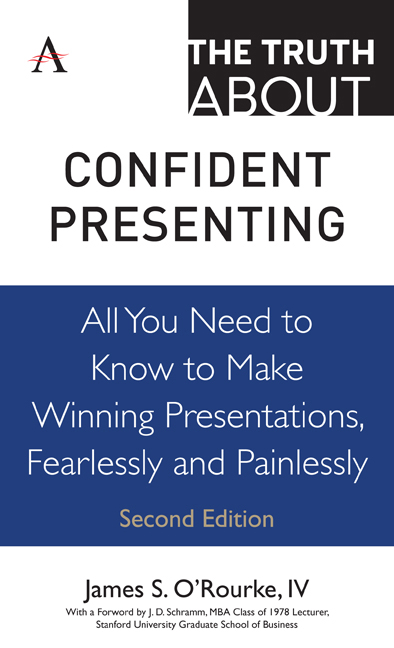 The Truth about Confident Presenting
The Truth about Confident Presenting Book contents
- Frontmatter
- Contents
- Foreword
- Introduction
- Part I Some Initial Truths
- Part II The Truth About Getting Ready to Speak
- Part III The Truth About What Makes People Listen
- Part IV The Truth About Developing Support for Your Presentation
- Part V The Truth About Getting Up to Speak
- Truth 25 Select a delivery approach
- Truth 26 Your introduction forms their first impression
- Truth 27 Begin with a purpose in mind
- Truth 28 Keep your audience interested
- Truth 29 Conclusions are as important as introductions
- Truth 30 Have confidence in your preparation
- Truth 31 Repeat the process as often as possible
- Part VI The Truth About Managing Anxiety
- Part VII The Truth About Nonverbal Communication
- Part VIII The Truth About Visual Aids
- Part IX The Truth About Handling an Audience
- Part X The Truth About What Makes a Presentation Work
- References
- Acknowledgments
- About the Author
Truth 26 - Your introduction forms their first impression
from Part V - The Truth About Getting Up to Speak
- Frontmatter
- Contents
- Foreword
- Introduction
- Part I Some Initial Truths
- Part II The Truth About Getting Ready to Speak
- Part III The Truth About What Makes People Listen
- Part IV The Truth About Developing Support for Your Presentation
- Part V The Truth About Getting Up to Speak
- Truth 25 Select a delivery approach
- Truth 26 Your introduction forms their first impression
- Truth 27 Begin with a purpose in mind
- Truth 28 Keep your audience interested
- Truth 29 Conclusions are as important as introductions
- Truth 30 Have confidence in your preparation
- Truth 31 Repeat the process as often as possible
- Part VI The Truth About Managing Anxiety
- Part VII The Truth About Nonverbal Communication
- Part VIII The Truth About Visual Aids
- Part IX The Truth About Handling an Audience
- Part X The Truth About What Makes a Presentation Work
- References
- Acknowledgments
- About the Author
Summary
How important is an introduction? Just ask Tufts University psychologist Nalini Ambady. She and a colleague videotaped 13 graduate teaching fellows as they taught their classes. She then took three random 10-second clips from each tape, combined them into one 30-second clip for each teacher and showed the silent clips to students who did not know the teachers. The students rated the instructors on 13 variables, such as “accepting,” “active,” “competent” and “confident.” Ambady combined these individual scores into one rating for each instructor and then correlated that rating with the teachers’ end-of-semester evaluation from actual students.
“We were shocked at how high the correlation was,” she said. “It was 0.76. In social psychology, anything above 0.6 is considered very strong.” Curious to see how thin she could make the video slices before affecting the students’ accuracy, Professor Ambady cut the length of the silent clips to 15 seconds, then to 6. Each time, the students accurately predicted the most successful teachers.
In his best-selling book, Blink: The Power of Thinking Without Thinking, author Malcom Gladwell explains at length how quick, first impressions are not only lasting, but frequently quite accurate. Although listeners sometimes make mistakes, particularly if they're focused on the wrong things at first, it's certainly true that they make judgments that are both durable and very powerful in forming lasting impressions of the speaker and the subject.
Introductions serve a number of other functions in addition to creating an opportunity for listeners to form first impressions. At a primary level, a speech introduction arouses the audience's attention and provides them with an incentive to listen. It also can provide some background on the speaker, the occasion and the reasons for the speech itself. If you're introduced by someone else, of course, they'll do that for you. They'll also give the audience a chance to settle down, arrange their coats, briefcases, backpacks and coffee cups, and perhaps turn off their cell phones. In the early moments of an introduction, very few people are paying close attention to anything other than the fact that the 26 presentation has begun. And that's fine, that's one of the purposes of an introduction.
- Type
- Chapter
- Information
- The Truth about Confident PresentingAll You Need To Know To Make Winning Presentations, Fearlessly And Painlessly, pp. 103 - 106Publisher: Anthem PressPrint publication year: 2019


